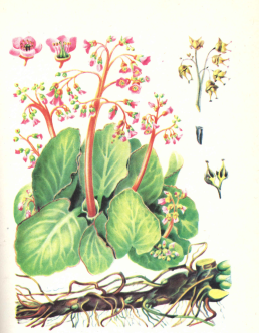FAMILY SAXIFRAGACEAE BADAN CRASSIFOLIA — BERGENIA CRASSIFOLIA FRITSCH
A low-growing perennial herb with a strong horizontal branching cylindrical rhizome, which reaches a considerable length, yellow-brown on the outside and light-brown on the inside. The leaves are all basal, gathered in a dense rosette, large (up to 35 cm), broadly elliptical, with long, wide petioles, evergreen, leathery (slightly crenate edges), dark green, shiny, with dotted glands on the underside (visible under a magnifying glass). The floral scapes are thick and tall, carrying a large, spreading, complex inflorescence in the form of a short, dense panicle, with branches ending in coils. The flowers are lilac-pink, with a five-lobed calyx, fused at the base; five petals, ten stamens; the ovary is semi-inferior and bi-chambered; the fruit is a capsule.
The distribution area of Bergenia is very limited. It grows in Siberia, in the mountain coniferous taiga (forests dominated by fir and spruce), on rocks and rocky slopes (in the Altai, Sayan Mountains, around Lake Baikal, on the Yablonovy Ridge, and extends to the Olekma River).
The rhizomes of Bergenia (Rhizoma Bergeniae) are harvested in the autumn. The rhizomes are easily pulled from the soil by hand. They are cleaned from dirt and small roots, washed with water, cut into long pieces, and dried. A limited amount of leaves are also collected.
The rhizome contains 15-28% tannins, mainly belonging to the pyrogallol group, and free polyphenols. The glucoside bergenin, in the form of colorless crystals, has been isolated, which belongs to the isoquinoline derivative group. The ballast substances include a large amount of starch and sugars.

The leaves are also rich in tannins and additionally contain the glucoside arbutin (10-20%) and free hydroquinone (2-4%) (methyl arbutin is absent). It can be used similarly to bearberry.
The rhizome is used in the form of a decoction (6:200, boiled for 20 minutes, taken 1 tablespoon) or liquid extract (15 drops before meals) as an astringent for gastrointestinal diseases and in gynecology for douching: 1 tablespoon of extract in 1 liter of water.
Bergenia preparations have hemostatic, astringent, anti-inflammatory, and antimicrobial properties. They are used for gastrointestinal diseases and externally for gargling in cases of stomatitis and gingivitis.
Folk medicine recommends Bergenia infusion for treating throat conditions and headaches.
